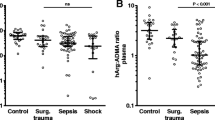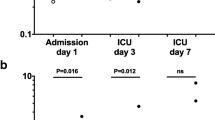Abstract
Objective
To investigate whether the production of nitric oxide (NO) relates to the development of renal insufficiency and multiple organ dysfunction syndrome (MODS) in patients with severe sepsis.
Design
Prospective study in 23 patients with severe sepsis.
Setting
Medical and surgical intensive care units (ICU) of three hospitals.
Measurements and results
Serum nitrate levels, as an indirect parameter of the production of NO in vivo, and scores for renal insufficiency and MODS were determined in patients with severe sepsis during a 1-week period after admission to the ICU. The highest serum nitrate levels were found at 4 h (mean 52±16 μmol/l) after entry into the study and the levels gradually declined thereafter. Patients with renal insufficiency had considerably higher serum nitrate levels during the study period than patients who did not develop renal insufficiency (MANOVA,p<0.05). Serum nitrate levels correlated with scores for renal insufficiency (r=0.60,p<0.001), and far exceeded the levels that can be explained solely by reduced renal clearance of nitrate. Further analysis showed that serum nitrate levels significantly and positively correlated with scores for MODS (r=0.44,p<0.001).
Conclusion
Our results indicate that the production of NO correlates with renal insufficiency and MODS in patients with severe sepsis and that this reactive nitrogen intermediate could be involved in the pathogenesis of organ failure in these critically ill patients.
Similar content being viewed by others
References
Parrillo JE (1993) Pathogenetic mechanisms of septic shock. N Eng J Med 328: 1471–1477
Natanson C, Hoffman WD, Suffredini AF, Eichacker PQ, Danner RL (1994) Selected treatment strategies for septic shock based on proposed mechanisms of pathogenesis. Ann Intern Med 120: 771–783
Groeneveld ABJ, Bronsveld W, Thijs LG (1985) Hemodynamic determinants of mortality in human septic shock. Surgery 99: 140–152
Moncada S, Higgs A (1993) Thel-arginine-nitric oxide pathway. N Engl J Med 329: 2002–2012
Ochoa JB, Udekwu AO, Billiar TR, Curran RD, Cerra FB, Simmons RL, Peitzman AB (1991) Nitrogen oxide levels in patients after trauma and during sepsis. Ann Surg 21: 621–626
Evans T, Carpenter A, Kinderman H, Cohen J (1993) Evidence of increased nitric oxide production in patients with the sepsis syndrome. Cric Shock 41: 77–81
Gomez-Jimenez J, Salgado A, Mourelle M, Martin MC, Segura RM, Peracaula R, Moncada S (1995)l-arginine: nitric oxide pathway in endotoxemia and human septic shock. Crit Care Med 23: 253–258
Wong HR, Carcillo JA, Burckart G, Shah N, Janosky JE (1995) Increased serum nitrite and nitrate concentrations in children with the sepsis syndrome. Crit Care Med 23: 835–842
Morris SM, Billiar TR (1994) New insights into the regulation of inducible nitric oxide synthesis. Am J Physiol 226: E829-E839
Groeneveld PHP, Colson P, Kwappenberg KMC, Clement J (1995) Increased production of nitric oxide (NO) in patients infected with the European variant of Hantavirus. Scand J Infect Dis 27: 453–456
Lorente JA, Landin L, de Pablo R, Renes E, Liste D (1993)l-arginine pathway in the sepsis syndrome. Crit Care Med 21: 1287–1295
van Dissel JT, Groeneveld PHP, Maes B, van Furth R, Frolich M, Feuth HD (1994) Nitric oxide: a predictor of morbidity in postoperative patients? Lancet 343: 1579–1580
Groeneveld PHP, Ringers J, van Dissel JT (1994) Effect of nitric oxide on renal function in septic shock. N Engl J Med 330: 1620
Statman R, Cheng W, Cunningham JN, Henderson JL, Damiani P, Siconolfi A, Rogers D, Horovitz JH (1994) Nitric oxide inhibition in the treatment of the sepsis syndrome is detrimental to tissue oxygenation. J Surg Res 57: 93–98
Cobb JP, Natanson C, Hoffman WD, Lodato RF, Banks S, Koev CA, Solomon MA, Elin RJ, Hosseini JM, Danner RL (1994) N omega-amino-l-arginine, an inhibitor of nitric oxide synthase, raises vascular resistance but increases mortality rates in awake canines challenged with endotoxin. J Exp Med 176: 1175–1182
Bone RC, Balk RA, Cerra FB, Dellinger RP, Fein AM, Knaus WA, Schein RMH, Sibbald WJ (1992) Definitions for sepsis and organ filure and guidelines for the use of innovative therapies in sepsis. Chest 101: 1644–1655
Bernard GR, Doing G, Hudson LD, Lemeshow S, Marshall JC, Russell J, Sibbald W, Sprung CL, Vincent JL, Wheeler AP (1995) Quantification of organ failure for clinical trials and clinical practice. Am J Respir Crit Care Med 151: A323
Wagner DA, Schultz DS, Deen WM, Young VR, Tannenbaum SR (1983) Metabolic fate of an oral dose of15N-labeled nitrate in humans: effect of diet supplementation with ascorbic acid. Cancer Res 43: 1921–1925
Hibbs JB, Westenfelder C, Taintor R, Vavrin Z, Kablitz C, Baranowski RL, Ward JH, Menlove RL, McMurry MP, Kushner JP, Samlowski WE (1992) Evidence for cytokine-inducible nitric oxide synthesis froml-arginine in patients receiving interleukin-2 therapy. J Clin Invest 89: 867–877
Jacob TD, Ochoa JB, Udekwu AO, Wilkinson J, Murray T, Billiar TR, Simmons RL, Marion DW, Peitzman AB (1993) Nitric oxide production is inhibited in trauma patients. J Trauma 35: 590–597
Yamamoto Y, Klein TW, Friedman H (1994) Endotoxin induced cytotoxicity of macrophages is due to apoptosis caused by nitric oxide production. J Endotoxin Res 1: 181–187
Palmer RMJ, Bridge L, Foxwell NA, Moncada S (1992) The role of nitric oxide in endothelial cell damage and its inhibition by glucocorticoids. Br J Pharmacol 105: 11–12
Hibbs JB, Taintor RR, Vavrin Z (1987) Macrophage cytotoxicity: role forl-arginine deiminase and imino nitrogen oxidation t to nitrite. Science 235: 473–476
Yu L, Gengaro PE, Niederberger M, Burke TJ, Schrier RW (1994) Nitric oxide: a mediator in rat tubular hypoxia/reoxygenation injury. Proc Natl Acad Sci USA 91: 1691–1695
Nathan C (1992) Nitric oxide as a secretory product of mammalian cells. FASEB J 66: 3051–3064
Mulligan MS, Hevel JM, Marletta MA, Ward PA (1991) Tissue injury caused by deposition of immune complexes isl-arginine dependent. Proc Natl Acad Sci USA 88: 6338–6342
Harbrecht BG, Billiar TR, Stadler J, Demetris AJ, Ochoa JB, Curran RD, Simmons RL (1992) Nitric oxide synthesis serves to reduce hepatic damage during acute murine endotoxemia. Crit Care Med 20: 1568–1574
Shultz PJ, Raij L (1992) Endogenously synthesized nitric oxide prevents endotoxininduced glomerular thrombosis. J Clin Invest 90: 1718–1725
Minnard EA, Shou J, Naama H, Cech A, Gallagher H, Daly JM (1994) Inhibition of nitric oxide synthesis is detrimental during endotoxemia. Arch Surg 129: 142–148
Hutcheson IR, Brendan JR, Boughton-Smith NK (1990) Role of nitric oxide in maintaining vascular integrity in endotoxin-induced acute intestinal damage in the rat. Br J Pharmacol 101: 815–820
Nava E, Palmer RMJ, Moncada S (1991) Inhibition of nitric oxide synthesis in septic shock: how much is beneficial? Lancet 338: 1555–1557
Pastor C, Teisseire B, Vicaut E, Didier P (1994) Effects ofl-arginine andl-nitroarginine treatment on blood pressure and cardiacoutput in a rabbit endotoxin shock model. Crit Care Med 22: 465–469
MacMicking JD, Nathan C, Hom G, Chartain N, Fletcher DS, Trumbauer M, Stevens K, Xie Q, Sokol K, Hutchinson N, Chen H, Mudgett JS (1995) Altered responses to bacterial infection and endotoxic shock in mice lacking inducible nitric oxide synthase. Cell 81: 641–650
Kubes P, Suzuki M, Granger DN (1991) Nitric oxide: an endogenous modulator of leucocyte adhesion. Proc Natl Acad Sci USA 88: 4651–4655
Kurose I, Kubes P, Wolf R, Anderson DC, Paulson J, Miyasaka M, Granger DN (1993) Inhibition of nitric oxide production. Mechanisms of vascular albumin leakage. Circ Res 73: 164–167
Radomski MW, Palmer RMJ, Moncada S (1990) Anl-arginine/nitric oxide pathway present in human platelets regulates aggregation. Proc Natl Acad Sci USA 87: 5193–5197
Oliver JA (1992) Endothelium-derived relaxing factor contributes to the regulation of endothelial permeability. J Cell Physiol 141: 505–511
St John RC, Dorinsky PM (1994) An overview of multiple organ dysfunction syndrome. J Lab Clin Med 124: 478–483
Spain DA, Wilson MA, Bloom ITM, Garrison RN (1994) Renal microvascular responses to sepsis are dependent on nitric oxide. J Surg Res 56: 524–529
Mulder MF, van Lambalgen AA, Huisman E, Visser JJ, van den Bos G, Thijs LG (1994) Protective role of nitric oxide (NO) in the regional hemodynamic changes during acute endotoxemia in rats. Am J Physiol 266: H1558-H1564
Author information
Authors and Affiliations
Additional information
This study is in part financially supported by BBL
Rights and permissions
About this article
Cite this article
Groeneveld, P.H.P., Kwappenberg, K.M.C., Langermans, J.A.M. et al. Nitric oxide (NO) production correlates with renal insufficiency and multiple organ dysfunction syndrome in severe sepsis. Intensive Care Med 22, 1197–1202 (1996). https://doi.org/10.1007/BF01709336
Received:
Accepted:
Issue Date:
DOI: https://doi.org/10.1007/BF01709336




